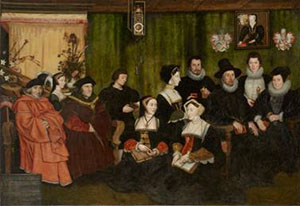
A collaboration between the National Portrait Gallery, its regional partner the National Trust, and the University of Bristol, “Pictured and Seen: Objects in Portraits” brings together painted portraits with objects such as timepieces, books, instruments and glassware. All three institutions are lending to the display, which will be the first occasion Montacute House has combined the Gallery’s portraits with objects from the National Trust’s Collections.
Highlights include the pairing of the National Portrait Gallery’s large group portrait of Sir Thomas More and his family with a later example from the National Trust’s Collections of the lantern clock featured in the painting; apothecary scales are shown alongside similar ones depicted in the portrait of the statesman and poet Sir Thomas Challoner and a 17th-century glass bottle is matched to the example seen in the portrait of Elizabeth Urrey.
The display explores the idea that portraiture is rarely simply the recording of a person’s facial features. Objects and attributes were often included in portraits to refer to an individual’s characteristics or interests. Some items were specially chosen to allude to a sitter’s profession, family connections, religious piety or political aspiration, while others were included as part of fashionable portrait formulas.
“Pictured and Seen: Objects in Portraits” will run until November 2015.
# # #

